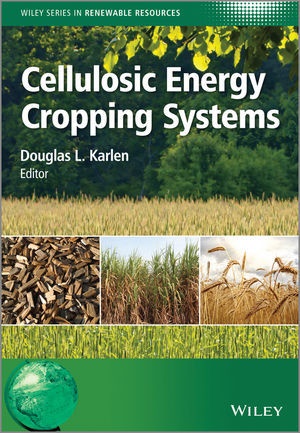Read more
Cellulosic Energy Cropping Systems presents a comprehensive overview of how cellulosic energy crops can be sustainably produced and converted to affordable energy through liquid fuels, heat and electricity.
The book begins with an introduction to cellulosic feedstocks, discussing their potential as a large-scale sustainable energy source, and technologies for the production of liquid fuels, heat and electricity. Subsequent chapters examine miscanthus, switchgrass, sugarcane and energy cane, sorghums and crop residues, reviewing their phylogeny, cultural practices, and opportunities for genetic improvement. This is followed by a detailed focus on woody crops, including eucalyptus, pine, poplar and willow. Critical logistical issues associated with both herbaceous and woody feedstocks are reviewed, and alternate strategies for harvesting, transporting, and storing cellulosic materials are also examined. The final sectionof the booktackles the challenge of achieving long-term sustainability, addressing economic, environmental and social factors.
Cellulosic Energy Cropping Systems is a valuable resource for academics, students and industry professionals working in the field of biomass cultivation and conversion, bioenergy, crop science and agriculture.
Topics covered include:
* Identifying suitable cellulosic energy crops that are adapted to a wide range of climates and soils
* Best management practices for sustainably growing, harvesting, storing, transporting and pre-processing these crops
* The development of integrated cellulosic energy cropping systems for supplying commercial processing plants
* Challenges and opportunities for the long-term sustainability of cellulosic energy crops
This book was conceived and initiated by David I. Bransby, Professor of Energy and Forage Crops in the Department of Crop, Soil and Environmental Sciences at Auburn University, USA.
For more information on the Wiley Series in Renewable Resources, visit www.wiley.com/go/rrs
List of contents
Foreword xvii
Series Preface xix
Preface xxi
List of Contributors xxiii
1 Introduction to Cellulosic Energy Crops 1
Mark Laser and Lee Lynd
1.1 Cellulosic Biomass: Definition, Photosynthesis, and Composition 1
1.2 Cellulosic Biomass Properties and Their Relevance to Downstream Processing 4
1.3 Desirable Traits and Potential Supply of Cellulosic Energy Crops 7
1.4 The Case for Cellulosic Energy Crops 8
2 Conversion Technologies for the Production of Liquid Fuels and Biochemicals 15
Sofie Dobbelaere, Tom Anthonis, and Wim Soetaert
2.1 Introduction 15
2.2 Biomass Conversion Technologies 16
2.3 (Bio)Chemical Conversion Route 17
2.4 Thermochemical Conversion Route 23
2.5 Summary and Conclusions 27
3 Technologies for Production of Heat and Electricity 31
Jacob J. Jacobson and Kara G. Cafferty
3.1 Introduction 31
3.2 Combustion 33
3.3 Repowering 35
3.4 Gasification 35
3.5 Pyrolysis 35
3.6 Direct Hydrothermal Liquefaction 37
3.7 Anaerobic Digestion 37
3.8 Integrated Biorefineries 38
3.9 Summary 39
4 Miscanthus Genetics and Agronomy for Bioenergy Feedstock 43
Maryse Brancourt-Hulmel, Charlotte Demay, Emeline Rosiau, Fabien Ferchaud, Linda Bethencourt, Stephanie Arnoult, Camille Dauchy, Nicolas Beaudoin, and Hubert Boizard
4.1 Introduction 43
4.2 Phylogeny, Growth, Yield and Chemical Composition 44
4.3 Cultural Practices 50
4.4 Genetic Improvement 57
4.5 Conclusion 65
5 Switchgrass 75
Rob Mitchell, D.K. Lee, and Michael Casler
5.1 Overview 75
5.2 Phylogeny, Growth, Yield and Chemical Composition 75
5.3 Cultural Practices 78
5.4 Genetic Improvement 82
5.5 Summary 85
6 Sugarcane, Energy Cane and Napier Grass 91
Edward P. Richard, Jr. and William F. Anderson
6.1 Sugar and Energy Cane 91
6.2 Napier grass 99
7 Sorghum 109
William L. Rooney
7.1 Introduction 109
7.2 Sorghum Phenology, Genetic Structure and Types 110
7.3 Cultural Practices 114
7.4 Genetic Improvement 118
7.5 Summary and Conclusions 123
8 Crop Residues 131
Douglas L. Karlen and David R. Huggins
8.1 Overview 131
8.2 Corn Stover 133
8.3 Wheat Straw 139
8.4 Future Opportunities 143
9 Eucalyptus 149
Michael W. Cunningham and Bijay Tamang
9.1 Phylogeny, Growth, Yield and Chemical Composition 149
9.2 Cultural Practices 153
9.3 Genetic Improvement 155
10 Pine 161
David B. South and Mathew Smidt
10.1 Introduction 161
10.2 Cultural Practices 165
10.3 Harvesting 173
10.4 Genetic Improvement 176
10.5 Economics 177
10.6 Government Regulations 179
10.7 Final Comments 180
11 Poplar 183
Andrzej Klasa and Doug Karlen
11.1 Introduction 183
11.2 Cultural Practices 184
11.3 Genetic Improvement 193
11.4 Utilization 193
11.5 Carbon Sequestration and Soil Response 194
12 Development and Deployment of Willow Biomass Crops 201
Timothy A. Volk, L.P. Abrahamson, T. Buchholz, J. Caputo, and M. Eisenbies
12.1 Introduction 201
12.2 Shrub Willow Characteristics 202
12.3 Production Systems for Willow Biomass Crops 204
12.4 Willow Biomass Crop Economics 208
12.5 Environmental and Rural Development Benefits 211
About the author
Dr Douglas L. Karlen, USDA, Agricultural Research Service, National Laboratory for Agriculture and the EnvironmentDr Karlen is an experienced research scientist in the Soil, Water, and Air Resources Research Unit at the USDA, Agricultural Research Service. His soil and crop management research program uses a systems approach involving research scientists and engineers, producers, action agencies, non-government organizations, agribusiness, and other state and federal partners to quantify physical, chemical, and biological effects of conventional and organic farming practices. His current focus is on sustaining or improving soil quality while striving to produce sustainable feedstock supplies for lignocellulosic biofuel production.
Summary
Cellulosic Energy Cropping Systems presents a comprehensive overview of how cellulosic energy crops can be sustainably produced and converted to affordable energy through liquid fuels, heat and electricity.

